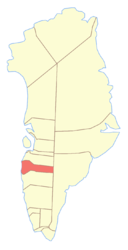Sisimiut district
| Sisimiut communiate Sisimiut district
|
||
|---|---|---|
 |
||
| Symbols | ||
|
||
| Basic data | ||
| Country | Greenland | |
| Commune | Qeqqata communia | |
| Seat | Sisimiut | |
| surface | 36,000 km² | |
| Residents | 6178 (January 1, 2018) | |
| density | 0.2 inhabitants per km² | |
Sisimiut has been a district in western Greenland since 2009 .
location
The Sisimiut District is centrally located in Greenland between the Kangaatsiaq District in the north and the Maniitsoq District in the south.
history
Until the colonial days
The district area was probably visited by the Grænlendingar in the Middle Ages , but it was certainly frequented regularly on the way north. The area was later visited by James Hall and John Cunningham during the first of Christian IV's first expeditions to Greenland in 1605 . They probably anchored their ships at Itilleq . In 1606 another expedition under Godske Lindenov reached the area. During a last expedition in 1612, Hall was murdered by the Greenlanders. Itilleq was also approached by David Danell between 1652 and 1655 . Lourens Feykes Haan described the island Zuydbay ( Ukiivik ) and the fjord Rommelpotten ( Nassuttooq ) at the beginning of the 18th century .
After Denmark began colonizing Greenland in 1721, a lodge was founded after Håbets Ø in the summer of 1724 in Nipisat , where Hamburg whalers had long been active. In the summer of 1725, however, Dutch whalers let the lodge burn down. In the summer of 1728 - at that time there was still only one colony in the country - Nipisat was rebuilt with greater defense. However, the whaling turned out to be unsuccessful, contrary to expectations. In 1731 the new King Christian VI. give up the colonization of Greenland and so in July 1731 all Danes were withdrawn. Just a month later, the Dutch burned down Nipisat again.
18th and 19th centuries
In 1756, the Holsteinsborg colony was founded in Ukiivik . Up until then, Dutch whalers had also traded there with the Greenlanders. In 1759 a mission lodge was founded in Asummiut . In 1760 the colony was moved to Sisimiut near Asummiut . In 1764 the mission was moved to Sisimiut.
The Greenland population at the beginning of the colonial period was mainly engaged in whaling. When the number of whales declined, many Greenlanders also moved, most of them north to Disko Bay , where they had families. Egill Þórhallsson named in the 1770s an abandoned residential area on the island of Maniitsorsuaq and one on the island of Uummannaarsussuaq .
As is usually the case in Greenland, the population was genetically very mixed by the beginning of the 20th century. There were probably no more pure Inuit . This was due to the comparatively high number of European colonialists who married into the Greenland families from the start. All Greenlanders were baptized by the end of the 18th century.
In 1773 there was an epidemic that killed many Greenlanders. In 1778, Qerrortusoq was founded as a second place in the colonial district. In 1788, 353 people lived in the colonial district. In 1789 the whaling lodge became independent. In 1801 there was another smallpox epidemic brought in from Aasiaat . At that time, 400 people lived in the colonial district. Of these, 357 died. 17 survived the disease and only 26 people did not become infected. Many residential areas died out completely, in others only a few children survived. Years later there were still numerous skeletons in the houses, for example in Uummannaarsuk . During the epidemic, Qerrortusoq also had to be given up, but was re-established as Udsted shortly afterwards . It was not until the middle of the 19th century that further Udsted were built, first in Ukiivik , where yarn fishing was given up again in 1845, then in Sarfannguit and Itilleq . By 1850 the population had risen to 752 people. In the winter of 1856/57 there was a famine in which 150 people were killed. Shortly afterwards, many more people moved to North Greenland. In 1860 around 100 people died from a wave of colds. Another 50 people died in 1864. Subsequently, only 519 people lived in the colonial district.
Younger story
From 1792 the missionary of the colony was also responsible for the colonial district of Sukkertoppen . On the other hand, with a short exception, the doctor from the Sukkertoppen colony was responsible for Holsteinsborg from 1906 to 1913.
In 1911 the colonial district was divided into the four parishes Holsteinsborg , K'errortussoĸ , Sarfánguaĸ and Itivdleĸ . In 1918, a total of five residential spaces were subordinate to these communities. 776 people lived in the colonial district at this time. During the administrative reform in 1950, the colony district became the municipality of Sisimiut. In 2002 the previously unincorporated area of Kangerlussuaq was incorporated into the municipality of Sisimiut. During the administrative reform in 2009, the municipality of Sisimiut was incorporated into the Qeqqata Kommunia .
places
In addition to the city of Sisimiut , the following villages are located in the Sisimiut district:
In addition, the following abandoned settlements are in what is now the district area:
In addition, the abandoned Qaqqatoqaq station is located in the Sisimiut district.
coat of arms
Blazon : A silver walrus head in blue .
literature
- Jens Christian Madsen: Udsteder og bopladser i Grønland 1901-2000 . Atuagkat, 2009, ISBN 978-87-90133-76-4 .
- Ole Bendixen , Louis Bobé : Beskrivelse af Distrikterne i Sydgrønland: Holsteinsborg District . In: Georg Carl Amdrup , Louis Bobé , Adolf Severin Jensen , Hans Peder Steensby (eds.): Grønland i tohundredeaaret for Hans Egedes landing (= Meddelelser om Grønland . Volume 60-61 ). tape 2 . C. A. Reitzel Boghandel, Copenhagen 1921, p. 1–94 ( digitized in the Internet Archive ).
Coordinates: 66 ° 57 ′ N , 53 ° 39 ′ W

